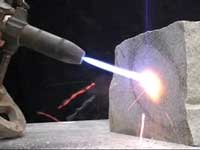Modeling of hydrothermal flames for rock drilling applications: experimental and theoretical approaches
Researcher: Chad Augustine
Principal Investigator: Professor Jefferson Tester
 Drilling costs are a major factor in considering the economic feasibility of activities such as oil and gas extraction and geothermal energy production. Conventional drilling methods use a drill bit attached to the end of a long, rotating drill string to crush and grind rock. Due to the need to periodically remove the drill string from the hole and replace the worn out drill bit, conventional drilling costs increase greatly with depth, making drilling beyond certain depths for a given amount of resource prohibitively expensive. Spallation drilling provides a means of drilling that does not require frequent replacement of the drill bit, resulting in substantially lower drilling costs at great depths and therefore making a greater amount of resources available for economically feasible development. Spallation drilling consists of rapidly heating a rock surface using flame jets to induce thermal compressive forces that fracture the rock and cause it to be violently ejected, or "spalled", from the rock surface in the form of chips. Spallation has been used in the quarrying industry since the 1950's for drilling blast holes in granite, but has always been performed in shallow open air holes at ambient pressures. This project focuses on applying the technique in deep boreholes under high pressure, high density aqueous conditions.
Drilling costs are a major factor in considering the economic feasibility of activities such as oil and gas extraction and geothermal energy production. Conventional drilling methods use a drill bit attached to the end of a long, rotating drill string to crush and grind rock. Due to the need to periodically remove the drill string from the hole and replace the worn out drill bit, conventional drilling costs increase greatly with depth, making drilling beyond certain depths for a given amount of resource prohibitively expensive. Spallation drilling provides a means of drilling that does not require frequent replacement of the drill bit, resulting in substantially lower drilling costs at great depths and therefore making a greater amount of resources available for economically feasible development. Spallation drilling consists of rapidly heating a rock surface using flame jets to induce thermal compressive forces that fracture the rock and cause it to be violently ejected, or "spalled", from the rock surface in the form of chips. Spallation has been used in the quarrying industry since the 1950's for drilling blast holes in granite, but has always been performed in shallow open air holes at ambient pressures. This project focuses on applying the technique in deep boreholes under high pressure, high density aqueous conditions.
The objective of this project is to quantitatively understand combustion flames under high pressure/high density hydrothermal conditions and to apply these flames to rock drilling. A reactor for carrying out such experiments has been conceived and designed, and a hydrogen-oxygen flame has been chosen as the model system. This set-up can be used to characterize the shape and ignition/extinction properties of the hydrothermal flames, and to induce spallation and/or fusion of rocks placed in the reactor. These observations can then be used to develop a semi-empirical model of the flame spallation process.